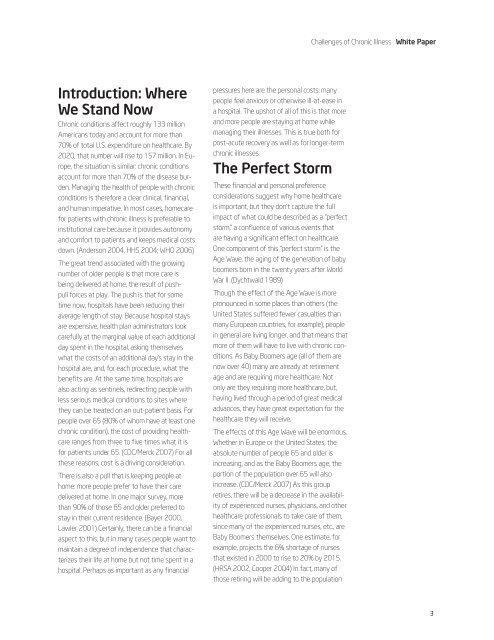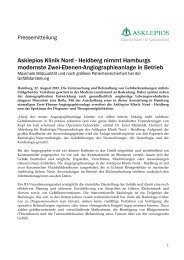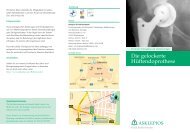Download Sammelmappe - Asklepios
Download Sammelmappe - Asklepios
Download Sammelmappe - Asklepios
Sie wollen auch ein ePaper? Erhöhen Sie die Reichweite Ihrer Titel.
YUMPU macht aus Druck-PDFs automatisch weboptimierte ePaper, die Google liebt.
Introduction: Where<br />
We Stand Now<br />
Chronic conditions affect roughly 133 million<br />
Americans today and account for more than<br />
70% of total U.S. expenditure on healthcare. By<br />
2020, that number will rise to 157 million. In Europe,<br />
the situation is similar: chronic conditions<br />
account for more than 70% of the disease burden.<br />
Managing the health of people with chronic<br />
conditions is therefore a clear clinical, financial,<br />
and human imperative. In most cases, homecare<br />
for patients with chronic illness is preferable to<br />
institutional care because it provides autonomy<br />
and comfort to patients and keeps medical costs<br />
down. (Anderson 2004, HHS 2004; WHO 2006)<br />
The great trend associated with the growing<br />
number of older people is that more care is<br />
being delivered at home, the result of pushpull<br />
forces at play. The push is that for some<br />
time now, hospitals have been reducing their<br />
average length of stay. Because hospital stays<br />
are expensive, health plan administrators look<br />
carefully at the marginal value of each additional<br />
day spent in the hospital, asking themselves<br />
what the costs of an additional day’s stay in the<br />
hospital are, and, for each procedure, what the<br />
benefits are. At the same time, hospitals are<br />
also acting as sentinels, redirecting people with<br />
less serious medical conditions to sites where<br />
they can be treated on an out-patient basis. For<br />
people over 65 (80% of whom have at least one<br />
chronic condition), the cost of providing healthcare<br />
ranges from three to five times what it is<br />
for patients under 65. (CDC/Merck 2007) For all<br />
these reasons, cost is a driving consideration.<br />
There is also a pull that is keeping people at<br />
home: more people prefer to have their care<br />
delivered at home. In one major survey, more<br />
than 90% of those 65 and older preferred to<br />
stay in their current residence. (Bayer 2000,<br />
Lawler 2001) Certainly, there can be a financial<br />
aspect to this, but in many cases people want to<br />
maintain a degree of independence that characterizes<br />
their life at home but not time spent in a<br />
hospital. Perhaps as important as any financial<br />
pressures here are the personal costs: many<br />
people feel anxious or otherwise ill-at-ease in<br />
a hospital. The upshot of all of this is that more<br />
and more people are staying at home while<br />
managing their illnesses. This is true both for<br />
post-acute recovery as well as for longer-term<br />
chronic illnesses.<br />
The Perfect Storm<br />
These financial and personal preference<br />
considerations suggest why home healthcare<br />
is important, but they don’t capture the full<br />
impact of what could be described as a “perfect<br />
storm,” a confluence of various events that<br />
are having a significant effect on healthcare.<br />
One component of this “perfect storm” is the<br />
Age Wave, the aging of the generation of baby<br />
boomers born in the twenty years after World<br />
War II. (Dychtwald 1989)<br />
Though the effect of the Age Wave is more<br />
pronounced in some places than others (the<br />
United States suffered fewer casualties than<br />
many European countries, for example), people<br />
in general are living longer, and that means that<br />
more of them will have to live with chronic conditions.<br />
As Baby Boomers age (all of them are<br />
now over 40) many are already at retirement<br />
age and are requiring more healthcare. Not<br />
only are they requiring more healthcare, but,<br />
having lived through a period of great medical<br />
advances, they have great expectation for the<br />
healthcare they will receive.<br />
The effects of this Age Wave will be enormous.<br />
Whether in Europe or the United States, the<br />
absolute number of people 65 and older is<br />
increasing, and as the Baby Boomers age, the<br />
portion of the population over 65 will also<br />
increase. (CDC/Merck 2007) As this group<br />
retires, there will be a decrease in the availability<br />
of experienced nurses, physicians, and other<br />
healthcare professionals to take care of them,<br />
since many of the experienced nurses, etc., are<br />
Baby Boomers themselves. One estimate, for<br />
example, projects the 6% shortage of nurses<br />
that existed in 2000 to rise to 20% by 2015.<br />
(HRSA 2002, Cooper 2004) In fact, many of<br />
those retiring will be adding to the population<br />
Challenges of Chronic Illness White Paper<br />
3

















